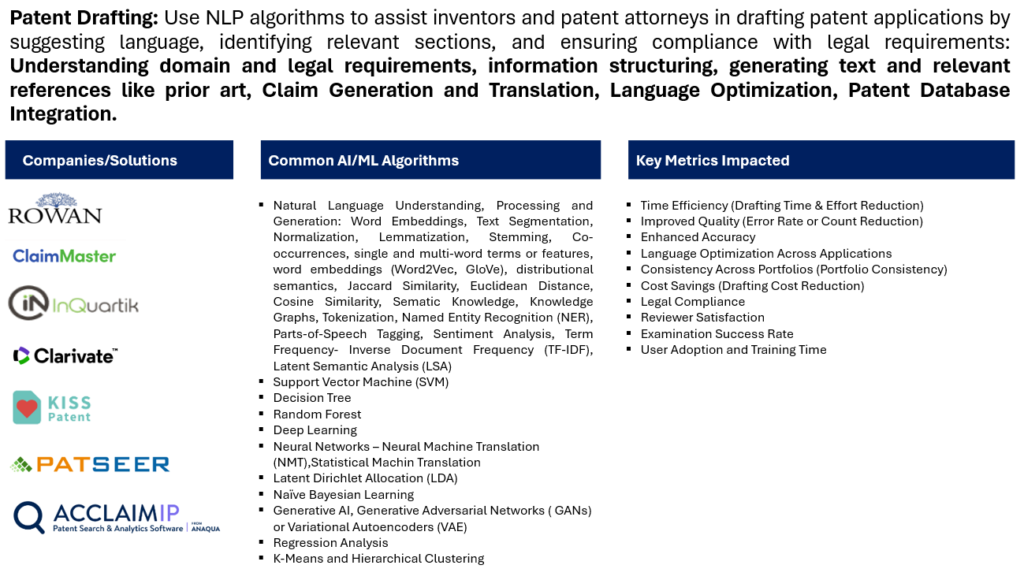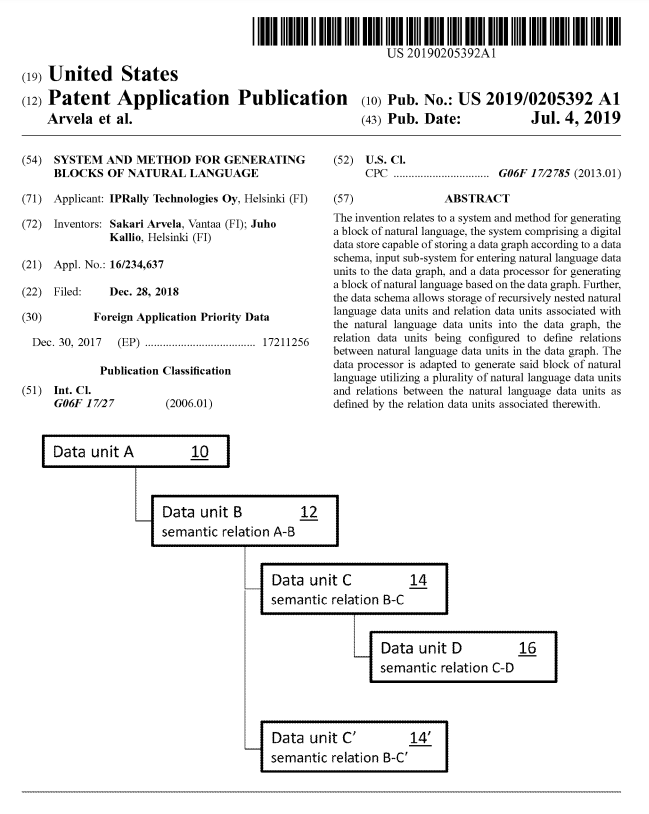Artificial Intelligence (AI) and Machine Learning (ML) can significantly impact patent management by automating and optimizing various tasks. By leveraging AI and ML in these areas, patent management processes can become more efficient, accurate, and proactive, ultimately enhancing the overall effectiveness of intellectual property management strategies. There are several applications and areas where AI/ML can be applied in patent management: Prior Art Search, Automated Patent Drafting, Patent Classification, Patent Valuation, Automated Patent Filing and Prosecution, Patent Portfolio Management, Patent Analytics, Infringement Detection, Technology Landscape Analysis, Patent Litigation Support, Automated Patent Maintenance and Collaborative Innovation Platforms.
B: Patent Drafting
Automating the drafting of patents involves a combination of advanced technologies, domain expertise, and careful consideration of legal requirements. (1) Have a thorough understanding of the specific industry, technology, and legal requirements relevant to the patent being drafted. Knowledge of patent law and regulations is crucial. (2) Gather relevant data, including technical information, prior art, and details about the invention. Utilize data processing techniques to organize and structure the information for analysis. (3) Implement NLP techniques to analyze and understand the language used in patent documents. This includes identifying key terms, concepts, and legal language specific to patent drafting. (4) Develop or leverage machine learning models to assist in various aspects of drafting, such as: Claim generation. Specification drafting. Identifying relevant prior art. (5) Apply semantic analysis to understand the context and meaning of terms used in patent documents. This helps in improving the precision of language used in patent drafts. (6) Incorporate rule-based systems to ensure compliance with legal and patent office guidelines. This involves enforcing specific rules related to patent drafting, formatting, and language.
(7) Explore generative models, such as Generative Adversarial Networks (GANs) or Variational Autoencoders (VAEs), for generating new and optimized content in patent drafts. (8) Integrate the automated drafting system with patent databases to perform real-time searches for relevant prior art and ensure that the drafted claims are novel and non-obvious. (9) Implement quality assurance mechanisms to review the drafts generated by the automated system. This may involve human review to ensure accuracy, completeness, and compliance with legal standards.
(10) Adopt an iterative approach and continuously refine the AI models based on feedback and evolving requirements. Keep the system up-to-date with changes in patent laws and regulations. (11) Develop a user-friendly interface that allows patent professionals to interact with the automated system. Enable collaboration between AI tools and human experts for optimal results. (12) Ensure that the automated drafting system adheres to legal and ethical standards. It should respect intellectual property rights, privacy, and confidentiality. (13) Provide training and education for patent professionals using the automated system. Familiarize them with the capabilities, limitations, and best practices for utilizing AI in patent drafting. (14) Implement robust security measures to protect sensitive information. Ensure compliance with data privacy regulations and standards.

AI and ML algorithms are being employed in various ways to assist in drafting patents. The specific algorithms used may vary depending on the functionalities required by the patent drafting tools or platforms: Natural Language Processing (NLP): Understanding and processing human language in the patent documents. Tokenization, Named Entity Recognition (NER), Part-of-Speech Tagging, Sentiment Analysis. Applications: Analyzing patent claims, understanding technical language, and improving the clarity of patent descriptions. Machine Translation: Translating technical documents or prior art from one language to another. Neural Machine Translation (NMT), statistical machine translation. Applications: Facilitating cross-border collaboration and ensuring understanding of foreign language patents. Text Mining and Information Retrieval: Extracting relevant information from large sets of text data. TF-IDF (Term Frequency-Inverse Document Frequency), Latent Semantic Analysis (LSA), Word Embeddings (e.g., Word2Vec, GloVe). Prior art search, extracting relevant information from patent databases, and identifying key concepts. Predictive Analytics: Predicting outcomes, trends, or potential issues related to patent applications. Regression analysis, Decision Trees, Random Forest, Support Vector Machines (SVM). Predicting patent grant outcomes, assessing the likelihood of patent infringement or litigation.
Generative Models: Generating new content, such as patent claims or descriptions. Generative Adversarial Networks (GANs), Variational Autoencoders (VAEs). Assisting in the creation of patent drafts and generating alternative wording for claims. Rule-based Systems: Applying predefined rules to analyze and structure patent-related information. Expert systems, rule-based engines. Enforcing patent drafting guidelines, ensuring compliance with legal requirements. Semantic Analysis: Understanding the meaning and context of terms used in patent documents. Semantic similarity measures, ontologies. Enhancing the precision of search results, improving language optimization in patent drafts. Cluster Analysis: Grouping similar patents or documents together based on certain criteria. K-means clustering, Hierarchical clustering. Organizing patent portfolios, identifying technology trends.
Here are some companies that were active in the field of AI/ML-powered patent drafting: InventionHub (now part of Dennemeyer): InventionHub, acquired by Dennemeyer (AcclaimIP), offers AI-driven patent drafting solutions. Their platform leverages natural language processing and machine learning to assist in the patent application drafting process. PatSnap: PatSnap provides a suite of intellectual property analytics tools, and they incorporate AI and machine learning to assist in various aspects of the patent lifecycle, including drafting. Legal Robot: Legal Robot applies natural language processing and machine learning to analyze legal documents, including patents. While not specifically focused on patent drafting, their technology could be adapted to assist in drafting processes. Docket Alarm (now part of Fastcase): Docket Alarm, now part of Fastcase, offers legal research and analytics services. Their platform incorporates AI for legal analytics, and they may have features related to patent drafting. IBM Watson for Patents: IBM Watson offers a range of AI-powered solutions, and their Watson for Patents platform uses AI to analyze patent data and assist in the patent drafting process.
KISSPatent: KISSPatent uses AI to automate various aspects of the patent application process, including drafting. Their platform aims to simplify patent filings for inventors and businesses. Voyage Patent AI: Voyage Patent AI is a company that focuses on using AI and natural language processing for patent drafting. Their platform aims to assist patent attorneys and inventors in creating high-quality patent applications. Anaqua: Anaqua provides intellectual property management solutions, including AI-driven tools for patent drafting and prosecution. Their platform aims to streamline the IP lifecycle, including drafting, docketing, and portfolio management. ClaimMaster: ClaimMaster is a patent drafting and prosecution automation tool that utilizes AI. It assists users in generating patent claims, checking for errors, and automating repetitive tasks in the patent application process.
Gridlogics (PatSeer): Gridlogics offers PatSeer, an IP analytics platform that incorporates AI and machine learning. It includes features for prior art searching, patent drafting, and portfolio management. Darts-ip: While Darts-ip primarily focuses on IP case law data, their platform incorporates AI to assist in various IP-related tasks. The platform may offer features related to patent drafting and analysis. InQuartik Corporation (Patentcloud): InQuartik’s Patentcloud platform includes AI-driven tools for patent analysis and drafting. It offers features for prior art searches, patent portfolio analysis, and competitive intelligence.
The application of Artificial Intelligence (AI) and Machine Learning (ML) technologies in drafting patents offers various benefits, and there are key performance indicators (KPIs) that can be used to measure the effectiveness of these applications. By tracking these KPIs, organizations can gain insights into the efficiency, accuracy, and overall performance of AI/ML technologies in the patent drafting process. Continuous monitoring and optimization based on these metrics can further enhance the benefits derived from AI/ML applications in patent drafting:
Time Efficiency: AI/ML can automate repetitive and time-consuming tasks in patent drafting, leading to faster completion of patent applications. Improved Quality: AI-powered tools can assist in generating high-quality patent drafts by analyzing vast datasets, ensuring consistency, and minimizing errors. Enhanced Accuracy: ML algorithms can learn from vast amounts of patent data, reducing errors in drafting and ensuring that the claims are accurate and well-structured. Language Optimization: AI can assist in optimizing the language used in patent applications, ensuring that the claims and descriptions comply with legal standards and are more likely to withstand examination challenges. Consistency Across Portfolios: AI/ML helps maintain consistency in language and structure across a portfolio of patent applications, ensuring a unified approach. Cost Savings: Automated drafting can lead to cost savings by reducing the time and effort required by human drafters, allowing organizations to allocate resources more efficiently.
Legal Compliance: AI applications can help ensure that patent drafts comply with legal requirements and guidelines, reducing the risk of issues during examination. Drafting Time: Measure the time taken to draft a patent application using AI/ML tools compared to traditional manual methods. Error Rate: Assess the accuracy of AI-generated drafts by comparing the error rate with manually drafted applications. Consistency Across Applications: Evaluate the degree of consistency in language, terminology, and structure across a set of patent applications generated using AI. Legal Compliance: Track how well AI/ML-generated drafts adhere to legal standards and patent office guidelines. Reviewer Satisfaction: Collect feedback from patent attorneys or reviewers on the quality, clarity, and completeness of AI-drafted patent applications. Cost Reduction: Measure the cost savings achieved by using AI/ML for patent drafting compared to traditional methods. Examination Success Rate: Assess the success rate of patent applications drafted using AI/ML during the examination process, including the rate of granted patents. Time to Grant: Measure the time it takes for AI-drafted patent applications to be granted compared to manually drafted applications. Portfolio Consistency: Evaluate the level of consistency in language and structure across an organization’s entire patent portfolio. User Adoption and Training Time: Monitor how quickly patent professionals can adopt and effectively use AI/ML tools for drafting, considering the learning curve and training time required.
B: Example

The invention presents a system for creating natural language blocks, including a digital data store following a data schema, an input subsystem for adding natural language data units to the data graph, and a data processor for generating a natural language block based on the data graph. The data schema supports recursive nesting of natural language and relation data units, defining relationships between them. Input is facilitated through user interface means, such as graphical interfaces. Relations can include semantic, thematic, quantity, and logic relations, enhancing the sophistication and depth of the generated natural language content.
References
Automated Patent Drafting:
Book: “Drafting Patents for Litigation and Licensing” by Michael A. Lehman
Article: “Automated Patent Drafting: Challenges and Opportunities” by Y. T. Haileselassie and K. A. Alhassan (International Journal of Computer Applications, 2016)
Article: “The Impact of Artificial Intelligence on Patent Law” by Ryan Abbott (Houston Law Review, 2018)
Blog Post: “How AI is Transforming the Patent Drafting Process” by IPWatchdog
Online Resource: LegalZoom’s Guide to Patent Drafting




